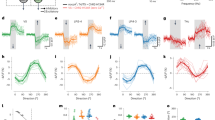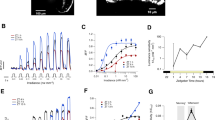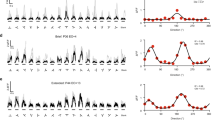Abstract
GIANT homolateral interneurones in the third optic ganglion of flies respond to visual stimulation with graded potentials only, lacking spike generation for signal transmission in physiological conditions1. (The term ‘homolateral’ is used here in its anatomical connotation of neurones which are anatomically restricted to one side of the brain5.) Graded potentials were thought to be the means of signal transmission of all three classes of homolateral giant elements of this neuropile region, that is, the ‘vertical cells’ (V cells), the ‘centrifugal horizontal cells’ (CH cells) and the ‘horizontal cells’ (H cells): both CH and H cells are mainly sensitive to horizontal pattern movement, whereas the V cells respond mainly to vertically moving patterns1,2. (The CH cells have an additional sensitivity to vertical, some V cells to horizontal pattern motion.) However, there is experimental proof that these findings might be valid only for the CH cells in which exclusively graded potentials could be recorded showing discrete excitatory and inhibitory postsynaptic potentials1,2. For the V cells, however, it has been shown that spiking can be induced by application of hyperpolarising currents2. In the absence of hyperpolarising currents, graded potentials with superimposed ‘local’ action potentials of small amplitude were observed1,2. The H cells, on the other hand were reported to generate only ‘local’ action potentials superimposed on to postsynaptic slow potentials1: these findings1 are not compatible with the previous3 results or with the results presented here which demonstrate regular action potential activity in H cells in physiological conditions.
This is a preview of subscription content, access via your institution
Access options
Subscribe to this journal
Receive 51 print issues and online access
$199.00 per year
only $3.90 per issue
Buy this article
- Purchase on Springer Link
- Instant access to full article PDF
Prices may be subject to local taxes which are calculated during checkout
Similar content being viewed by others
References
Hausen, K. Z. Naturforsch. 31c, 629–633 (1976); Thesis, Univ. Tübingen (1976).
Eckert, H. & Bishop, L. G. J. comp. Physiol. (in the press).
Eckert, H. Proc. Ger. Zool. Soc. Hamburg 69, 84 (1976).
Pierantoni, R. S. Biokybernetik 5, 157–163 (1974).
Strausfeld, N. J. (ed.) in Atlas of an Insect Brain (Springer, Berlin, 1976); In Neural Principles in Vision. (Springer, Berlin, 1976).
Eckert, H. & Boschek, C. B. Experimental Entomology Neuroanatomical Techniques (eds Miller, T. A. & Strausfeld, N. J.) (Springer, Berlin, 1978).
Author information
Authors and Affiliations
Rights and permissions
About this article
Cite this article
ECKERT, H. Response properties of dipteran giant visual interneurones involved in control of optomotor behaviour. Nature 271, 358–360 (1978). https://doi.org/10.1038/271358a0
Received:
Accepted:
Published:
Issue Date:
DOI: https://doi.org/10.1038/271358a0
This article is cited by
-
Visual interneurons in the lobula complex of the fleshfly,Boettcherisca peregrina
Journal of Comparative Physiology A (1985)
-
Convergence of visual, haltere, and prosternai inputs at neck motor neurons of Calliphora erythrocephala
Cell and Tissue Research (1985)
-
Lobula plate and ocellar interneurons converge onto a cluster of descending neurons leading to neck and leg motor neuropil in Calliphora erythrocephala
Cell and Tissue Research (1985)
-
Motion sensitive interneurons in the optomotor system of the fly
Biological Cybernetics (1982)
-
The second and third optic ganglia of the worker bee
Cell And Tissue Research (1981)
Comments
By submitting a comment you agree to abide by our Terms and Community Guidelines. If you find something abusive or that does not comply with our terms or guidelines please flag it as inappropriate.



